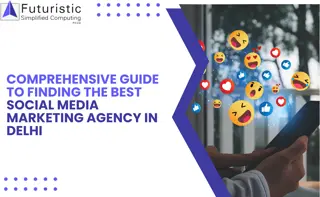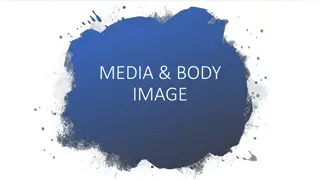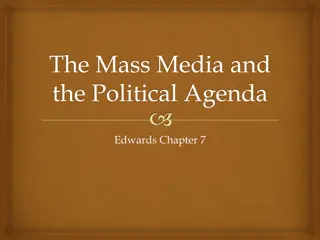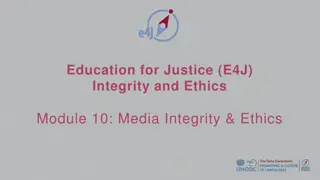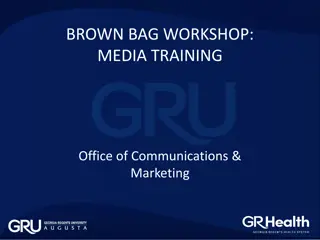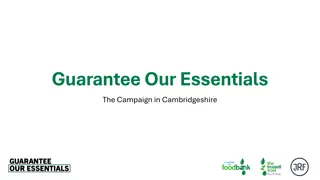Comprehensive Guide to Media Training Essentials
This comprehensive guide provides essential training for effective media communication, emphasizing preparation, control in interviews, and audience relevance. Five key parts cover theory, practice, confrontation, evaluation, and more. Participants can customize the training based on goals, preferences, and group size. The guide offers tips, exercises, and structured modules to enhance media communication skills for various mediums like TV, radio, and publications.
Uploaded on Sep 25, 2024 | 0 Views
Download Presentation

Please find below an Image/Link to download the presentation.
The content on the website is provided AS IS for your information and personal use only. It may not be sold, licensed, or shared on other websites without obtaining consent from the author. Download presentation by click this link. If you encounter any issues during the download, it is possible that the publisher has removed the file from their server.
E N D
Presentation Transcript
So youd like to give a media training? Great! Just as we feel anyone can do a great interview, we feel it s not just experienced trainers that can give press trainings - but everyone taking an interest in (science) communication and having some idea on the workings of the media. Of course, preparation is key. That s where this set of slides comes in. This pop-up training guide is built up out of five parts that should be the basis of any media training. For each part, the goal is stated, as well as some important points. For the theory and practice parts, modules can be selected depending on your and your participants preference, goals and constraints. As such, feel free to change, extend or skip parts, and make it yours. We do strongly encourage you to stick to the current sequence of parts as we feel that results in the best possible learning experience. An exception are theory and practice: you can alternate these in order to put a particular theory in practice immediately. The presentation notes provide additional suggestions, clarifications or references to the material presented on the slide.
Essentials There are three main points you want to bring across to the scientists you are training: 1. Never give an interview unprepared. Always take time to think about what you want to say, the points you want to make, and the examples and numbers to illustrate and support those points. 2. As the one being interviewed you have a lot of control over the course of the interview. Using your examples, and simple techniques like 'bridging' (sparingly), you can steer the interview in the direction you would like it to go. 3. Make sure that what you are saying is relevant to the audience looking at, listening to or reading the interview. What does your research mean for them, why would they want to know this, or in two simple words: 'So what?'. If the scientists in your training - whether it is short or long - take away with them these essentials, you can consider it a success.
Before you begin Ask about the learning goals of your participants. Do they have to appear on tv, want to write a press release or speak at a conference? Different goals have different means so adjust accordingly. How long should your training last, and do you and your students prefer to focus on the theory or on practicing? In order to assist you adapting this training given the above answers, you ll find a number of icons used throughout these pages, mostly regarding exercises. Suitable for one-on-one trainings or trainings in small groups (< 5 persons) Suitable for trainings in larger groups (> 5 persons) Aimed to train for publications in the paper (/blog/magazine/ ) Aimed to train for radio-interviews (/podcasts/ ) Aimed to train for TV-appearances and photo-ops 1 3 hourglass-symbols indicate the estimated time (short to long)
Parts 1. Introduction 1. Goal / Target audience / Message / Medium 2. Control and sympathy 3. So what? Why is this news? 4. WWWWWH?! 5. Interviews 2. Confrontation 3. Theory 4. Practice 5. Evaluation
Introduction Part 1
Introduction Goal: create a safe space and a learning environment Get to know each other Establish learning goals Set clear rules
Confrontation Part 2
Confrontation Goal: show why this training is relevant and activate the participants - get their attention In this part, it is not per se the goal to give an accurate representation of an interview - a journalist will most likely ask more helpful questions in reality - but even then as interviewee you need to be able steer the interview. Therefore it is useful in such trainings to make a caricature of journalism, to ask slippery questions . Do an unconstructive interview with (one of) the participants and lead him/her up the garden path . Make sure to record this on video, to watch it during reflection (see next slide). Show a video of an interview that went bad.
Confrontation (2) After doing the confrontation, reflect on it (using suggestions from the audience ( ) or a small discussion ( )): What went well? What could have been better? A positive approach is important, especially when you ve interviewed one of the participants. As they didn t do so well, the participants need some encouragement to keep participating and not shut down completely.
Theory Part 3
Theory Goal: transfer (theoretical) knowledge Choose the modules (as listed from page 5 in the guide) that fit the learning goals of the participants. (Even though theories might be explained in a print-article context, they are often applicable to other mediums as well!)
Goal / Target audience / Message / Medium Goal, target group, message and means all should be aligned with each other. Goal: Target group: Message: Means: e.g. inform, persuade, activate, e.g. youngsters, students, industry, e.g. challenge this, invest in that, e.g. press release, video, social media post,
Goal / Target audience / Message / Medium (2) The message box can help you align these elements:
Control and sympathy Without control and sympathy, you will not get your message across to your audience. As an interviewee, you want to be in control of where the interview goes. However, you need to get/keep the sympathy of the audience.
So what? Why is this news? So what? is a very powerful question to keep asking until you get to the core of the problem / innovation / topic. Particular aspects of a story can make it (extra) newsworthy: Negativity Proximity Continuity Uniqueness Predictability Exclusivity Visual impact Emotion Prize Publication Recency Celebrity Size Conflict Celebrity
WWWWWH?! News stories are built up differently from scientific publications. News story Scientific publication Bottom line Background Supporting details So what? Supporting details Conclusion
WWWWH?! (2) News stories are supposed to provide answers. Therefore, they should answer what / when / why / who / where / how in the title or first sentences (or in the first few seconds of a video). Also pay attention to the so what? and why should I care? - questions.
Interviews Besides the earlier theory on getting your message across: know the journalist and story: what publication, when, who else is interviewed, full-blown interview or background, ? ask/demand and use preparation time keep it simple, keep it short use bridging questions (see practice section) to steer the interview but make sure you remain sympathetic off the record does not exist
Practice Part 5
Practice Goal: put theory into practice and build confidence Choose exercises for the modules treated in the theory part. In case of time constraints, use the time and group size indications as well as the learning goals of the participants to make a selection.
Goal / Target audience / Message / Medium Fill out the message box
Control and sympathy Bridging: don t always answer the question you re asked 0. Prepare stupid questions (suggestions below) 1. Make participants form pairs 2. Interviewee thinks of a core message 3. Have interviewer ask stupid questions, and have interviewee try to work around the question and state the core message 4. Repeat step 3 (don t re-use questions in the same pair) and/or change roles
So what? Why is this news? + WWWWWH?! Write a press release Max. 400 words Introduction (title + lead) includes WWWWWH Paragraphs in order of decreasing relevance So what?
Interviews Practice: an interview (great way for participants to redeem themselves for the earlier confrontation) a journalist calling
Example slide: When the phone rings... Why is the journalist calling? What medium do they represent? What do they want from you (background information, an interview...)? When is the piece going to be published/broadcast? When, where and how do they want to interview you? On the phone or in person? Who else is being interviewed? How can you contact the journalist? Ask for time to think and prepare, and say you will call back. Journalists are always in a hurry, but insist on your right to preparation time!
Example slide: Preparation Formulate your core messages two or three only Establish the five Ws: who, what, where, when, why The sixth W: wow! Know what you want to say. And what not Come up with appealing examples and/or comparisons Check out the journalist and their medium
Example slide: Take control Get to the core message as quickly as possible Stick to your message, and repeat it if you have to Keep your story easy to understand Don t use jargon Don t give too much information Be patient Separate facts from opinions Always be honest Don t be afraid of silences YOU decide what you say!
Example slide: Difficult questions Never, ever avoid the question! Instead, explain why it is a difficult question Stay calm, honest and positive! Take your time NEVER say No comment Give an answer Laugh, but not when inappropriate Deflect suggestive questions But DON T repeat negative words Be careful with friendly journalists Remember: they re doing their job!
Example slide: And finally... Has everything been said and asked? Is any additional material needed? Trust the journalist to do their job properly Offer to correct any factual inaccuracies Radio/tv: it is hardly ever possible to see the final edited version before broadcast How will you be captioned (name, title)? If you want to see something changed, make a friendly suggestion You cannot veto broadcast/publication!
Evaluation Part 6
Evaluation Goal: reflect on the training and give participants pointers for further (self-)study Discuss whether: all learning goals were achieved? all questions were answered? (most importantly) the participants feel prepared to deal with press? Share suggestions for further reading / training and contacts Ask participants to evaluate the training
Acknowledgments Our thanks go out to Fred Balvert (Erasmus MC, co-author of Prepare for 15 seconds of fame), Johan Vlasblom (Big Easy Communicatie) and Roy Meijer (TU Delft / SciCom NL), who provided input for this guide. And of course to Leon Baas, Lenny Bakker, Kimberly Barentsen, Maxime Bisschops, Bram Peerlings, Pascalle Vermeulen, the team of TU Delft InterSECtion students, who developed this guide as a Crash Case.








